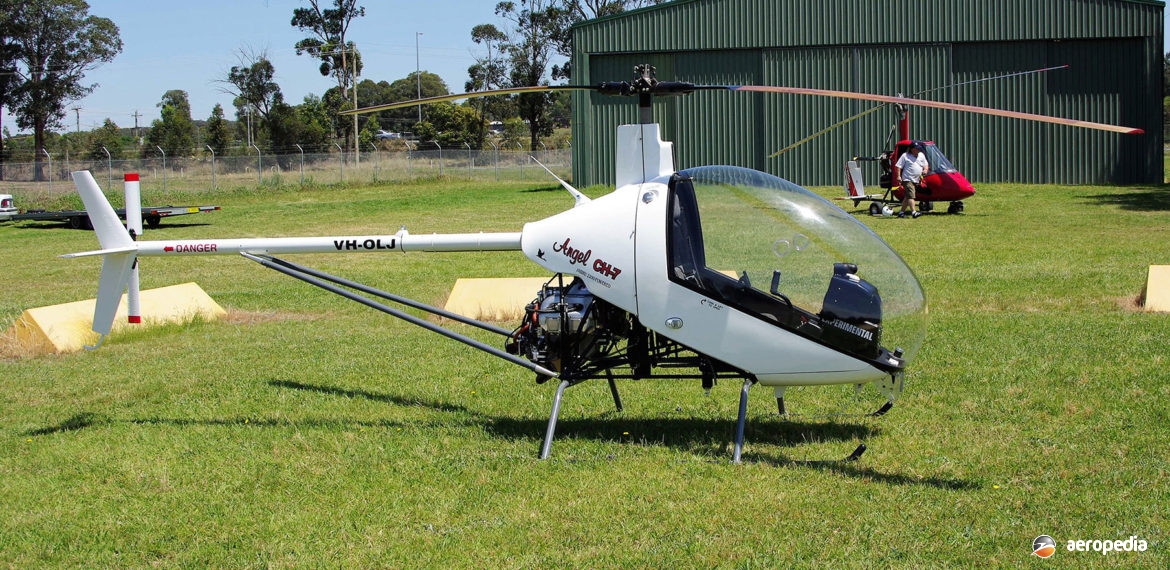Photograph:
Elisport CH-7 Angel VH-OLJ (c/n 025) at Hoxton Park, NSW (David C Eyre)
Country of origin:
Italy / United States of America
Description:
Single-seat homebuilt sport helicopter
Power Plant:
One 48 kw (65 hp) Rotax 582 two-cylinder, two-stroke, air-cooled engine
Specifications:
- Length: 7.15 m (23 ft)
- Height: 2.08 m (6 ft 9 in)
- Rotor diameter: 6 m (19 ft 7 in)
- Max speed: 140 km/h (86 mph)
- Cruising speed: 110 km/h (68 mph)
- Rate of climb: 366 m/min (1,200 ft/min)
- Max range: 330 km (205 miles)
- Hovering ceiling in ground effect: 2,100 m (7,000 ft)
- Hovering ceiling out of ground effect: 1,500 m (5,000 ft)
- Service ceiling: 3,500 m (11,000 ft)
- Range: 274 km (170 miles)
- Empty weight: 170 kg (374 lb)
- Loaded weight: 309 kg (682 lb)
History:
The Elisport CH-7 Angel was designed by Augusto Cicare in Argentina as a single-seat, light, cheap, sport helicopter powered by a 600 cc two-cycle two-cylinder dual-ignition liquid-cooled engine. Aimed at the market for transport, tourism and agricultural use, the structure was of steel trestle weld and aluminium tubes bolted together, the transmission being cardanic gear, being built oversize for strength. The type has been marketed by the manufacturer Strada Traforo del Pino in Torino, Italy, and by Elisport in the United States since the late 1980s. In 1997 Elisport became Heli-Sport.
The helicopter was first marketed as the Cicare CH-6 and was later developed by Josi and Claudio Barbero, with the assistance of Marcello Gandini, becoming the CH-7 Angel with a new enclosed cockpit from 1992. It became popular and a two-seat variant was developed as the CH-7 Kompress, fitted with an 86 kw (115 hp) Rotax 914 turbocharged engine, this providing a maximum speed of 208 km/h (129 mph). A later model became known as the CH-7 Kompress Charlie in 2005.
The pod and boom fuselage had a glass fibre cabin built of steel tube frame, had a fibreglass cockpit and had a long transparent canopy. The main rotor shaft was driven by a belt. The tail boom carried the tail rotor and the fins. An aluminium skid undercarriage was fitted and this could be fitted with small wheels for ground handling, and could also be fitted with inflatable floats for flying off water, this model being known as the Mariner. A later model was the CH-7B Spirit, fitted with a four-cylinder, four-stroke, dual-ignition engine.
Available in kit form, the first of the type seen in this region was demonstrated at the 1992 Avalon Air Show, VIC,the first registered being a Cicare CH-7 Angel VH-NGL (c/n N322) in 1995, which was followed by VH-NSU (c/n N427) in 1997, based in Western Australia, and ZK-HOU (c/n 34) in November 1997 in Auckland.
A number of examples have been imported over the years, including CH-7 Kompress VH-TTE (c/n 106), VH-EFO (c/n 0010) in July 2011, and ZK-HSR (c/n K93 – ex ZU-SEP) registered to Heli-Hind Helicopters of Hokitiki on 23 September 2014.
Others registered have included VH-SWQ³ (c/n 0011) which crashed near Barcaldine, QLD on 12 May 2014; VH-DSA² (c/n 014) registered in October 2011 but which was damaged by fire; VH-UBA³ (c/n 017) registered March 2012; VH-DPC (c/n 026) registered January 2014; VH-TNP (c/n 023) registered July 2013; VH-CLK (c/n 024) registered June 2013; VH-PPY (c/n 0022) registered July 2013; VH-AQO (c/n 21) registered July 2013 and VH-KOK (c/n 0015) registered November 2011.

